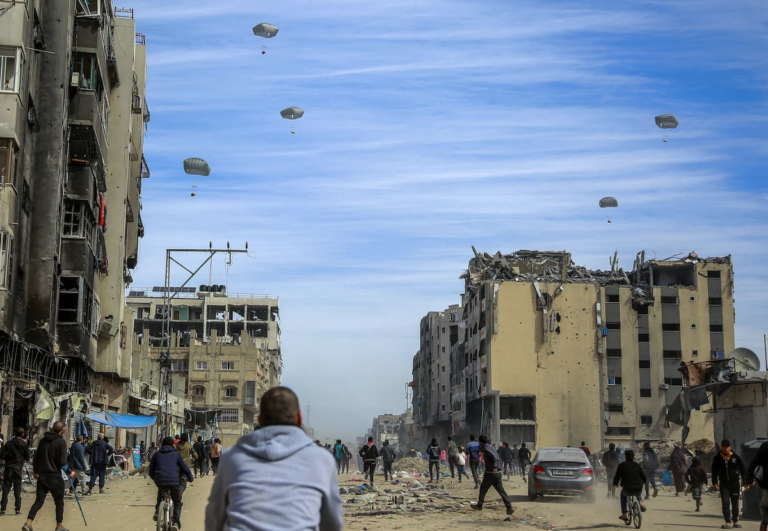Airdropping aid is inefficient — so why is the U.S. doing it in Gaza anyway?

U.S. and Jordanian forces have been dropping supplies in Gaza. (AFP via Getty Images)
U.S. military planes began airdropping food and supplies into Gaza over the weekend.
According to U.S. Central Command, American and Jordanian forces dropped some 38,000 meals with parachutes along Gaza’s coastline on Saturday.
Compare that with the need: More than 2 million people live in the Gaza Strip, and according to the U.N., a quarter of them face imminent starvation.
Jeremy Konyndyk is president of Refugees International and was the director of the U.S. Agency for International Development’s (USAID’s) Office of U.S. Foreign Disaster Assistance under President Barack Obama.
He spoke to All Things Considered host Ari Shapiro about why airdropping aid is a last resort and why he views it as a “grim irony” for the U.S. to be doing so now.
This interview has been lightly edited for length and clarity.
Interview highlights
Ari Shapiro: You helped coordinate airdrops during previous conflicts. So tell us about when they are most effective and how they can be most useful.
Jeremy Konyndyk: Well, the first thing to understand about airdrops is they are probably the most inefficient possible way to deliver aid. So they’re used very, very sparingly and only when there is truly no other way to get aid in.
So we would use them if a population was completely physically inaccessible, if they had been cut off by an earthquake or a hurricane, or if there was fighting or if they were besieged.
So, for example, when Iraqi Yazidis were fleeing the genocidal militia, the ISIL [Islamic State] militia that had pushed them out of their town, they fled up Sinjar mountain. And in 2014, when I was at [US]AID, we organized airdrops by the U.S. military onto Sinjar mountain to sustain them. Outside of those kind of situations, it’s very, very rare. I can’t think of one where we’ve used them in a place that was simultaneously being served by overland access.
Shapiro: Can you just explain why it is so inefficient, why it is such a last resort?
Konyndyk: First is cost. It is about — and obviously, every situation is a little different — but ballpark eight to 10 times as expensive logistically to deliver by air as by overland transport.
And the volumes are much smaller. So to put this in perspective, Samantha Power, the administrator of USAID, was in the Middle East last week, and she gave remarks in the West Bank where she was bemoaning the fact that only about 96 trucks per day, on average, had been getting into Gaza.
Well, the three planeloads that the U.S. dropped last week are equivalent to ballpark four to six truckloads. So it really is not a significant additional amount of aid relative to the already hugely inadequate amount that’s getting in.
Shapiro: That’s staggering, that not only is it eight to 10 times more expensive, but it’s the equivalent of four to six truckloads. And the number that President Biden himself has described as wholly insufficient is something like 96 trucks per day.
Konyndyk: Correct.
Shapiro: And so what kind of deliberations had to lead up to the decision that even given the inefficiency of it, given the cost of it, given that aid could come in by land, it is still at this point a good idea and necessary to do these airdrops from the sky?
Konyndyk: Well, I think it is reflective of just a level of frustration within the administration with the ongoing obstruction of more normal aid mechanisms by the Israeli government.
This came on the heels of the Israeli government attempting to organize their own distribution of aid into northern Gaza, after having spent most of the last two months blocking the U.N. and other aid organizations from doing more mainstream deliveries there.
You can see in the president’s rhetoric, you can see in what the vice president said over the weekend and what Administrator Power said in recent days: There’s clearly a rising level of frustration with the ongoing obstruction of aid by the Israeli government.
And I think what is quite striking about that is under the International Court of Justice order, Israel faces a requirement to do all they can to facilitate humanitarian aid. But also under U.S. law, there are prohibitions against providing security assistance to a country that is blocking the provision of U.S. humanitarian assistance. The plain language of what the president, vice president and administrator of USAID have said in recent days suggests that Israel is doing that.
Shapiro: Some people have criticized the U.S. as taking performative steps when the Biden administration is at the same time supporting the Israeli military’s war in Gaza. What do you make of that assessment?
Konyndyk: I think there is a really grim irony in the fact that the U.S. is supplying both the bombs that are dropping on Gaza and now the food parcels that are dropping on Gaza.
And I think it’s far past time — and most, I think, in the humanitarian community are now saying it is time — to put some real pressure and leverage on Israel over these blockages. And again, that is in our view required under U.S. law, that we should not be providing bombs to a government that is blocking aid from going into a population.
9(MDAzMzI1ODY3MDEyMzkzOTE3NjIxNDg3MQ001))




